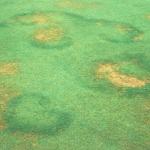Fairy Ring and Localized Dry Spot
Fairy ring is the common term used to describe circles of mushrooms, green circular bands of turf, or rings and arcs of dead plants in a turfgrass stand. Fairy ring symptoms may be caused by numerous species of soil and thatch inhabiting fungi of the Basidiomycetes class. Many of these fungi produce mushrooms or puffballs (basidiocarps). They reside in the thatch or other sources of organic matter such as dead tree roots. Fairy ring fungi grow radially outward from their point of initiation and release nitrogen from the degradation of thatch or other organic matter. These fungi do not directly parasitize turfgrasses, but can alter the soil environment in ways that affect turf health and physiology. They may produce a dense network of mycelia which repels water, making the soil hydrophobic (water repelling) and causing localized dry spot. Symptoms are most often observed in hot, dry weather, especially in nutrient deficient turf. Basidiocarps appear following heavy rain or irrigation.
Three types of Fairy ring have been described based upon symptoms:
- Type 1 symptoms consist of rings of necrotic or dead turf, sometimes with an inner or outer ring of dark green grass stimulated by nitrogen release.
- Type 2 appears as rings of dark, lush grass which may or may not produce fruiting bodies. Hydrophobic conditions of the soil and/or localized dry spot may be associated with both Type 1 and Type 2 fairy rings.
- Type 3 is limited to rings of basidiocarps, with no visible effect on turfgrass growth.
Fairy ring symptoms have been treated with a combination of cultural practices and chemical applications (fungicides, wetting agents) in various configurations; consistent and reliable control has not been achieved.
Cultural Management
- Provide a steady and consistent water supply, avoiding regular cycles of moist/dry soil.
- Keep localized dry spots very moist by frequent injection of water into and through the rings in dry weather. Deep punctures through the soil surface and addition of wetting agents enhance this approach.
- Prevent the accumulation of thatch as this deprives the fungi of a food source and slows their growth.
- Symptoms can often be masked by a combination of deep irrigation and carefully timed nitrogen applications. This promotes turf growth around and within the rings to match the growth of the stimulated rings. Iron applications can also be used to promote dark, green growth.
- Cultivation or mixing of soil can be labor intensive but may be effective. Soil must be thoroughly cultivated and soaked with water, then left unplanted for a period of time. Turf may be removed and restored as sod.
- Rapid eradication by soil replacement is an extreme but sometimes effective technique. The sod and underlying soil is removed to a depth of 8-30 inches, the soil replaced with clean, preferably sterilized topsoil, before turf is reestablished.
- Basidiocarps may be removed by hand.
Chemical Management
Applications of fungicides or wetting agents produce limited and inconsistent results. Numerous species of fungi produce fairy rings, and some are not sensitive to registered fungicides. In addition, the fungi often originate from deep in the soil where fungicides cannot reach. Success requires that the fungicides and/or wetting agents be well distributed throughout the soil by a combination of thorough irrigation and physical disruption of the soil surface.
For a listing of fungicides currently labeled to manage this disease, refer to the Disease Management chapter of UMass Extension's Professional Guide for IPM in Turf for Massachusetts.


